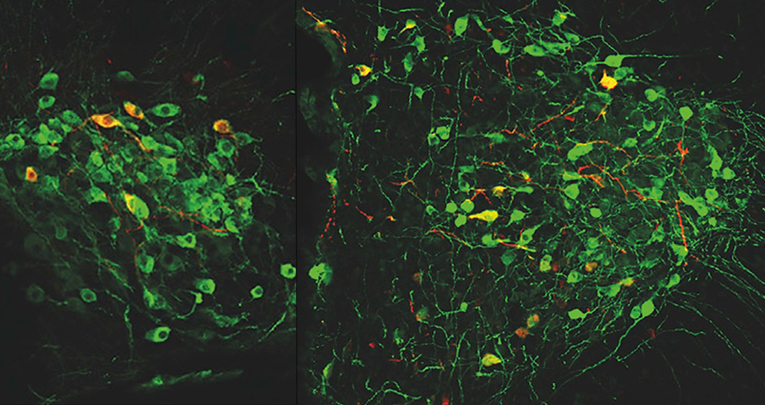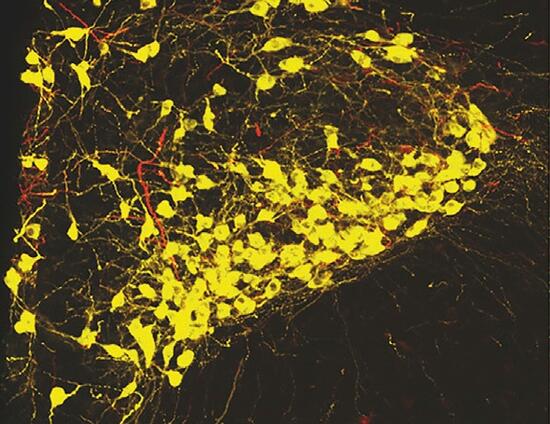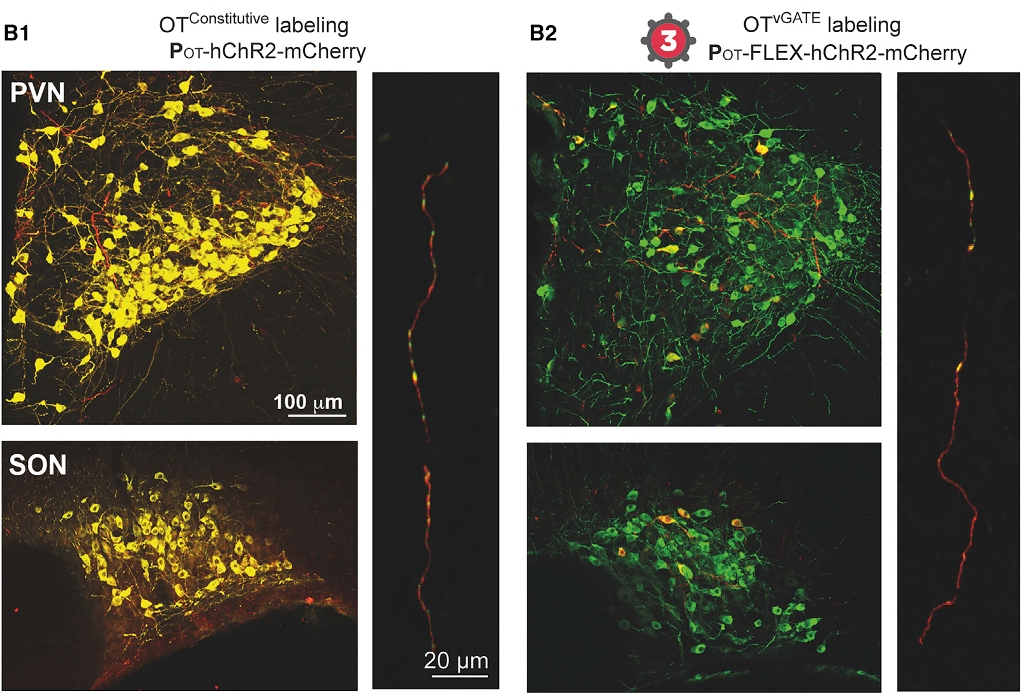09/06/2019
Hasan MT
1
, Althammer F
2
, Silva da Gouveia M
2
, Goyon S
3
, Eliava M
2
, Lefevre A
2
, Kerspern D
3
, Schimmer J
2
, Raftogianni A
2
, Wahis J
3
, Knobloch-Bollmann HS
2
, Tang Y
2
, Liu X
2
, Jain A
2
, Chavant V
3
, Goumon Y
3
, Weislogel JM
4
, Hurlemann R
5
, Herpertz SC
6
, Pitzer C
7
, Darbon P
3
, Dogbevia GK
8
,
Bertocchi I
9
, Larkum ME
10
, Sprengel R
9
, Bading H
4
, Charlet A
11
, Grinevich V
12
Oxytocin (OT) release by axonal terminals onto the central nucleus of the amygdala exerts anxiolysis. To investigate which subpopulation of OT neurons contributes to this effect, we developed a novel method: virus-delivered genetic activity-induced tagging of cell ensembles (vGATE). With the vGATE method, we identified and permanently tagged a small subpopulation of OT cells, which, by optogenetic stimulation, strongly attenuated contextual fear-induced freezing, and pharmacogenetic silencing of tagged OT neurons impaired context-specific fear extinction, demonstrating that the tagged OT neurons are sufficient and necessary, respectively, to control contextual fear.
Intriguingly, OT cell terminals of fear-experienced rats displayed enhanced glutamate release in the amygdala. Furthermore, rats exposed to another round of fear conditioning displayed 5-fold more activated magnocellular OT neurons in a novel environment than a familiar one, possibly for a generalized fear response. Thus, our results provide first evidence that hypothalamic OT neurons represent a fear memory engram.
B) The vast majority of OT neurons (99.4% ± 0.8%, green) of the PVN and SON were labeled via a constitutive OT promoter driving hChR2-mCherry (B1, red).
B2) Fear expression induced tagging (ChR2-mCherry, red) of a small population of OT neurons (green). (B1 and B2) Vertical panels depict ChR2-mCherry-containing axons (red) with OT-immunopositive puncta (green, appearing in yellow) in the CeL of both groups.
1
Laboratory of Memory Circuits, Achucarro Basque Center for Neuroscience, Science Park of the UPV/EHU, Sede Building, Barrio Sarriena, 48940 Leioa, Spain; Ikerbasque-Basque Foundation for Science, 48013 Bilbao, Spain; Neurocure, Charité-Universitätsmedizin, Virchowweg 6, 10117 Berlin, Germany; Max Planck Institute for Medical Research, Jahnstrasse 29, 69120 Heidelberg, Germany. Electronic address: mazahir.t.hasan@gmail.com.
2
Schaller Research Group on Neuropeptides, German Cancer Research Center, Im Neuenheimer Feld 307, 69120 Heidelberg, Germany.
3
Centre National de la Recherche Scientifique and University of Strasbourg, Institute of Cellular and Integrative Neurosciences, 8 Allée du Général Rouvillois, 67000 Strasbourg, France.
4
Department of Neurobiology, Heidelberg University, Im Neuenheimer Feld 364, 69120 Heidelberg, Germany.
5
Department of Psychiatry and Division of Medical Psychology, University of Bonn Medical Center, Sigmund-Freud-Strasse 25, 53105 Bonn, Germany.
6
Department of General Psychiatry, Center of Psychosocial Medicine, Heidelberg University, Voßstraße 4, 69115 Heidelberg, Germany.
7
Interdisciplinary Neurobehavioral Core (INBC), Heidelberg University, Im Neuenheimer Feld 515, 69120 Heidelberg, Germany.
8
Max Planck Institute for Medical Research, Jahnstrasse 29, 69120 Heidelberg, Germany.
9
University of Torino, Department of Neuroscience Rita Levi Montalcini and Neuroscience Institute Cavalieri Ottolenghi (NICO), Orbassano, 10043, Torino, Italy.
10
Neurocure, Charité-Universitätsmedizin, Virchowweg 6, 10117 Berlin, Germany.
11
Centre National de la Recherche Scientifique and University of Strasbourg, Institute of Cellular and Integrative Neurosciences, 8 Allée du Général Rouvillois, 67000 Strasbourg, France; University of Strasbourg Institute for Advanced Study (USIAS), Strasbourg, France. Electronic address: acharlet@unistra.fr.
12
Schaller Research Group on Neuropeptides, German Cancer Research Center, Im Neuenheimer Feld 307, 69120 Heidelberg, Germany; Department of Neuropeptide Research for Psychiatry, Central Institute of Mental Health, Heidelberg University, J5, 68159 Mannheim, Germany. Electronic address: v.grinevich@dkfz-heidelberg.de.










